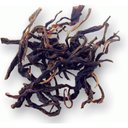Tea: Organic Sun Ripened Raw Puer
A Raw (Sheng) Pu-erh from The Tao of Tea - ![]() Organic
Organic
| Brand: | The Tao of Tea |
| Style: | Raw (Sheng) Pu-erh |
| Region: | Yunnan, China |
| Caffeine: | Caffeinated |
| Loose? | Loose |
| # Ratings: | 1 View All |
Reviewer: SarsyPie

✓ 119 teas reviewed
✓ 2 of Raw (Sheng) Pu-erh
✓ 3 of Pu-erh Tea
✓ 4 of The Tao of Tea
✓ 13 from Yunnan, China
✓ 30 from China
Review of Organic Sun Ripened Raw Puer
May 1st, 2014
| Aroma | Flavor | Value | Total |
| 7 of 10 | 4 of 5 | 4 of 5 | 73 of 100 |
| Very Good | Good | Good Value |
My first pu erh! Before steeping, I took a whiff and it smelled like a hardware store! Tried again: the second sniff smelled like tea and cookies. Much better!
This was surprisingly good. I was nervous about trying this style, but I was very happy. The tea was a light amber - quite pretty. It smells warm and sweet once brewed. I would definitely buy again.
The tea was smooth when hot, but left a slight chalky feel when it cooled. I don't suggest drinking it when cool, so it shouldn't be much of a problem. :)
Add your own review
Comments:
| Alex Zorach wrote: on May 2nd, 2014 |
I am sooo happy to see that your first Pu-erh was a "raw" Pu-erh (usually called "sheng" by connoisseurs).
The first several Pu-erh's that I tried were "shou"/"shu" or cooked/ripened pu-erh, which is sort of an accelerated aging process, some might say a "fake" process used to imitate the aging of the more traditionally processed teas.
Not all shou pu-erhs are bad (actually, the best one I've ever tried was from Tao of Tea) but my experience is that most of them are...not my cup of tea, a lot of them smell like a damp basement, possibly with some decaying leaf litter thrown in.
But anyway, it was years before I tried a Pu-erh that I liked, and when I did, I was like--wow, it can taste like this? It certainly wasn't my favorite tea ever but it was much better, and...I think from reading your review here you seem to have had a good first experience with Pu-erh, which is a good thing! So hopefully you've just bypassed all that awkwardness that I experienced.
| SarsyPie wrote: on May 2nd, 2014 |
Thanks for the info, Alex. I haven't done much reading on Pu-erh, but I have seen some comments and reviews from others, which is why I was a little nervous about this one. I've noticed that people seem to love or hate the style.
I've seen the terms "shou" and "sheng", but I didn't really know the difference, so I appreciate the explanation. I guess I just got lucky with this tea, because to be honest, I just picked one that had a nice description. LOL. Not the most scientific method, but it worked out here.
I just placed an order with Yezi tea and they have several Pu-erhs, so I requested samples. I think 2 of them mentioned being aged, but I'll have to check when they arrive to see if they are shou or sheng.
Do you have any tips for brewing each type? Many tea packages have suggested instructions, but this Sun Ripened Raw Puer did not. I kind of googled general Pu-erh brewing temps/times and gave it a stab.
| Alex Zorach wrote: on May 3rd, 2014 |
I've actually found Pu-erh to be not rather picky about brewing. I usually just use boiling water, and the only thing I watch is the steeping time, and even then I'm not that careful, longer steeps just seem to make it a little stronger. Good-quality Pu-erh has large, intact leaves that infuse slowly, which makes it easy to control the steeping time.
Sheng pu-erh can be very strong flavored when it's young (some people consider 10-15 year aging to still be "young") so I tend to recommend a shorter brewing time with it. Both shou and sheng pu-erh tend to resteep exceptionally easily--often I am able to get cup after cup and I stop brewing because I tire of drinking tea, not because the tea ran out of flavor. People who practice gong fu brewing often talk about making 20 or more steeps of some Pu-erh. Brewing western-style, with a mug and smaller amount of leaf, it's not uncommon for me to get 5-8 good steeps.
If you really want to learn about Pu-erh, you can go read from one of the experts...I'm a comparative novice about it. Bearsblog (puerh.blogspot.com), run by Jason, is a great place to start, because he has a "New To Puerh" section which is a great introduction.


